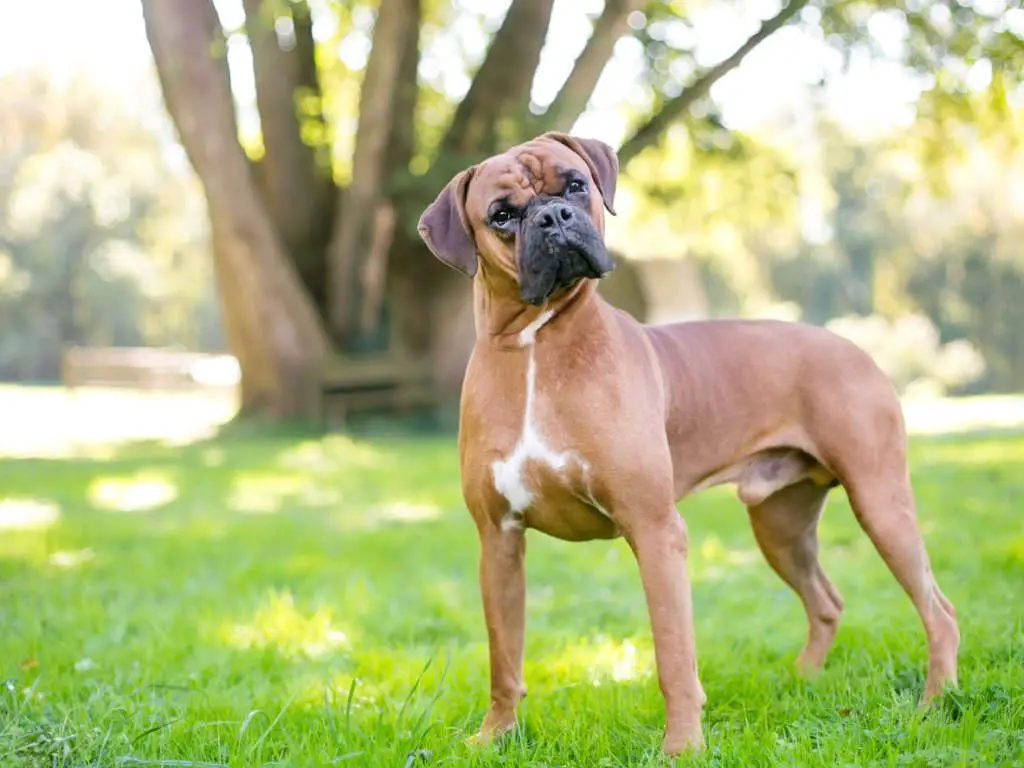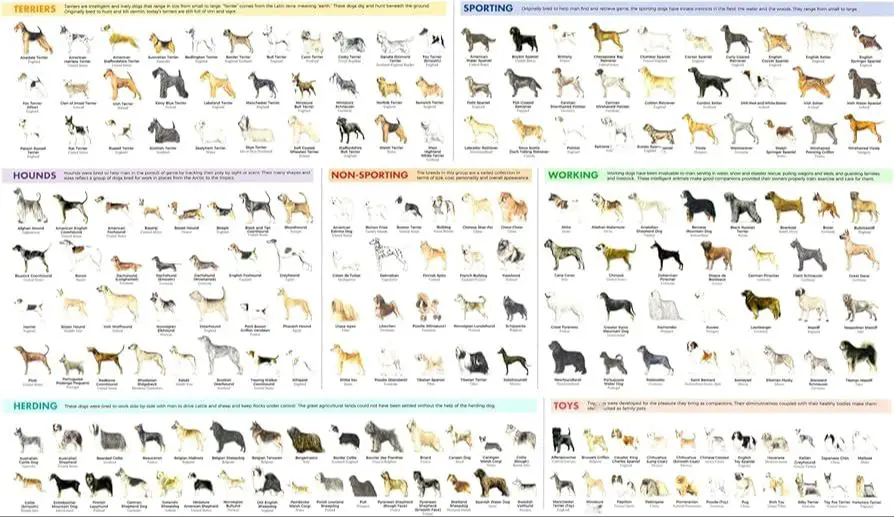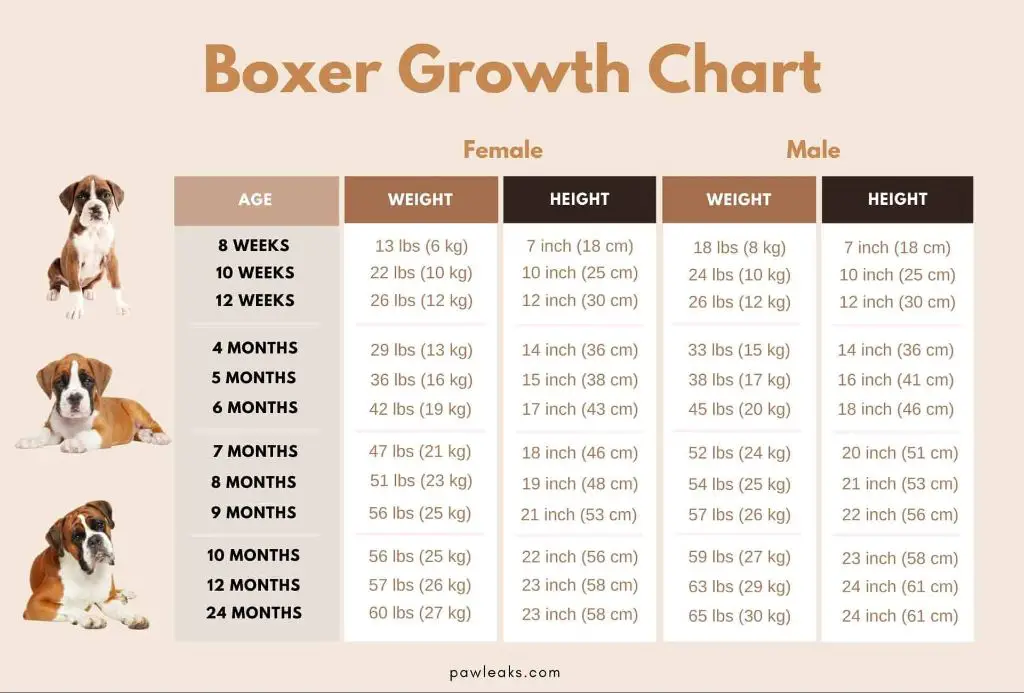Introduction
Boxer dogs are one of the most popular dog breeds in the United States and around the world. They are medium to large-sized dogs known for their playfulness, loyalty, and distinctive square muzzle. But exactly how big do boxers get? Are they considered a medium or large breed? In this article, we’ll take a look at the size standards for boxers and examine the factors that can influence their growth.
Finding out if boxers are medium or large dogs is helpful in determining whether they will suit your lifestyle and living situation. Their size can impact everything from exercise needs to space requirements. Understanding the typical size range for boxers will allow future owners to make the right decision about adding one of these energetic pups to their family.
Appearance
Boxers are medium to large-sized dogs with a stocky, muscular build. Adult male Boxers typically stand 22-25 inches tall and weigh about 65-80 pounds, while females stand 21-24 inches and weigh 50-70 pounds on average. The Boxer has a short, shiny coat that lies tight against the body and comes in fawn, brindle, or white with flashy markings. They have a sturdy, powerful body and square face with a broad skull and pronounced jaw. Their cropped ears stand erect, while their docked tail is set high.

According to the AKC breed standard, “The ideal Boxer is a medium-sized, square-built dog of good substance with short back, strong limbs, and short, tight-fitting coat. His well-developed muscles are clean, hard, and appear smooth under taut skin.” [1]
Size Categories for Dogs
Dogs come in a wide range of sizes, from tiny toy breeds to giant breeds. There are several common size categories used to classify dogs:
Toy breeds typically weigh less than 12 pounds. Examples include Chihuahuas, Yorkshire Terriers, and Pomeranians. These petite dogs were bred to be companions and can thrive in small living spaces.
Small breeds weigh 13 to 25 pounds. Popular small dog breeds are Dachshunds, Corgis, and French Bulldogs. Small dogs are portable and adaptable.
Medium breeds weigh 26 to 60 pounds. Some medium-sized breeds are Beagles, Basenjis, and Border Terriers. Medium dogs are great for active families.
Large breeds weigh 61 to 100 pounds. This category includes Retrievers like Golden Retrievers and Labrador Retrievers. Large dogs need room to move around.
Giant breeds are over 100 pounds. Great Danes, Mastiffs, and St. Bernards fall into this size class. Giant breeds require lots of space indoors and out.
So those are the main size categories used to classify dog breeds based on weight. Where a particular breed falls can vary depending on multiple factors.

Boxer Size Standards
The American Kennel Club’s (official breed standard for Boxers) outlines the size standards for the Boxer breed. According to the AKC standard, adult male Boxers should stand between 23 to 25 inches tall at the shoulder. Adult female Boxers are typically smaller, standing between 211⁄2 to 231⁄2 inches tall at the shoulder.
The AKC standard also specifies weight ranges for the breed. Male Boxers generally weigh between 60 to 70 pounds. Female Boxers weigh in a bit lighter, typically between 50 to 60 pounds.
There is some natural variation in size, as Boxers at the lower end of the height and weight scales are still considered within breed standards. But generally speaking, the AKC standard provides clear guidelines for the desired Boxer size for both male and female dogs.
Factors Affecting Size
There are several key factors that affect the size of boxers and other dog breeds. These include gender, genetics, and nutrition.
Gender plays a significant role, with male boxers generally being larger than females. According to the American Kennel Club breed standard, male boxers typically stand 22.5 to 25 inches tall, while females stand 21 to 23.5 inches. Males generally weigh 65 to 80 pounds, compared to females at 50 to 65 pounds.

Genetics are also an important determinant of size. Selective breeding over many generations has influenced boxers to fall within a certain size range. However, slight variations can occur even within the same litter due to the complex interplay of genes inherited from the parents. Two boxers from the same parents may ultimately have small differences in their final adult size and proportions.
Finally, nutrition throughout a boxer’s lifetime affects their growth and final size. Proper nutrition with adequate calories and vitamins/minerals, especially during the rapid growth phase of puppyhood, enables individuals to reach their full genetic size potential. Malnutrition can result in stunted growth. However, overnutrition leading to obesity can also strain the dog’s frame and is unhealthy. Following veterinary recommendations for feeding based on age, activity level, and other factors can help optimize a boxer’s size.
Is a Boxer Medium or Large?
The Boxer is generally considered a medium-sized dog breed according to most kennel club standards, but some people may view them as on the larger side of medium or even a large breed. According to the American Kennel Club (AKC) breed standard, the ideal height range for a male Boxer is 22.5 to 25 inches and for females is 21 to 23.5 inches (source). Their weight can range from 55 to 70 pounds for males and 50 to 65 pounds for females (source).
Compared to small dog breeds that are under 20 pounds, the Boxer is definitely larger. However, it falls below the size range of extra large dog breeds like Mastiffs and Great Danes. When looking at other medium-sized dogs like the Bulldog, Boston Terrier, and Labrador Retriever, the Boxer is similar in height and weight proportions. So while on the higher end of medium, the Boxer still fits squarely into the medium dog breed category according to most experts.
There can be some variations in size among individual Boxers that are considered acceptable per the AKC standard. Factors like gender, genetics, and nutrition can cause the size range to shift slightly up or down. But a well-bred Boxer that falls within the height and weight standards can be definitively categorized as a medium-sized dog breed.
Living with a Boxer
Boxers are active, energetic dogs that require daily exercise and stimulation. A bored boxer can become destructive or mischievous. Owners should be prepared to exercise their boxer for at least an hour each day. Activities such as walking, jogging, playing fetch, or participating in canine sports or agility will help meet the exercise needs of this breed.
Due to their muscular build, boxers are prone to overheating. Owners should avoid strenuous exercise during hot weather and provide access to shade and water. Cooling vests or mats may also help prevent overheating.
Boxers are intelligent and responds well to training, especially when it involves food rewards or games. Owners should use positive reinforcement techniques and be patient during training. Boxers can be stubborn, so persistence and consistency are key.
Some health issues to be aware of in boxers include cancer, heart conditions, hip dysplasia, hypothyroidism, and digestive issues. Responsible breeding and health screening can help minimize risks. Like all dogs, annual vet checkups, vaccinations, parasite prevention, and high-quality nutrition are important for lifelong health.
Overall, boxers make lively, fun-loving companions for active owners able to provide proper exercise, training, and health care. Their affectionate nature and playful antics make them a popular family pet. With the right care and environment, boxers can thrive as lifelong canine companions. Proper socialization and training from puppyhood is key to a well-behaved boxer.
Popularity of Boxers
Boxers are one of the most popular dog breeds in the United States. According to the American Kennel Club, Boxers were the 7th most popular breed in 2021 based on registration statistics. They have been in the top 10 most popular breeds for many years. In 2020, there were over 37,000 Boxer puppies registered with the AKC.

The popularity of Boxers has been steadily rising over the past decade. Boxer registrations increased by over 28% from 2011 to 2020, showing their growing popularity as family pets. Part of the appeal of Boxers is their playful, energetic, and loyal personality. They are often described as “clowns” and make excellent companions for active families.
While the Boxer breed originated in Germany, it has become beloved worldwide. According to the UK Kennel Club, Boxers consistently rank in the top 10 most popular breeds. Their fun-loving temperament and athleticism have earned them fans across the globe.
Boxers as Pets
Boxers make excellent family pets thanks to their playful temperament and gentle, loving nature. Known for being energetic, goofy, and highly affectionate, Boxers thrive when they can interact with their human family members (ASPCA Pet Insurance). They especially enjoy playtime and cuddling up close with their favorite people.
Playful Boxers are happy to romp around with kids for hours. Their friendly attitude makes Boxers very child-friendly. However, their boisterous energy means they may accidentally knock over smaller children. Boxers should always be supervised when around young kids (Daily Paws).
Boxers are also incredibly loyal and protective of their families. They aim to please their owners and often want to be close to their side. With proper training and socialization, Boxers can get along well with other pets too. Their affectionate personality helps them thrive in family environments.
Conclusion
In summary, the Boxer is considered a medium to large-sized dog breed. According to major kennel club standards, the ideal height for a male Boxer is between 22-25 inches at the shoulder and between 21-24 inches for a female. Their weight ranges between 55-70 pounds on average. However, some Boxers may be smaller or larger than the breed standard due to natural variation, gender, diet, and genetics. Although classified in the medium to large category, the Boxer is on the larger end of medium-sized breeds. Their sturdy, muscular build and energetic nature are characteristic of a bigger dog. When properly trained and socialized, the loyal Boxer makes an excellent family companion. With their playful and protective personality, they are a popular choice for many households. If you can accommodate and handle a medium-large breed, the Boxer may be the perfect dog for you.
